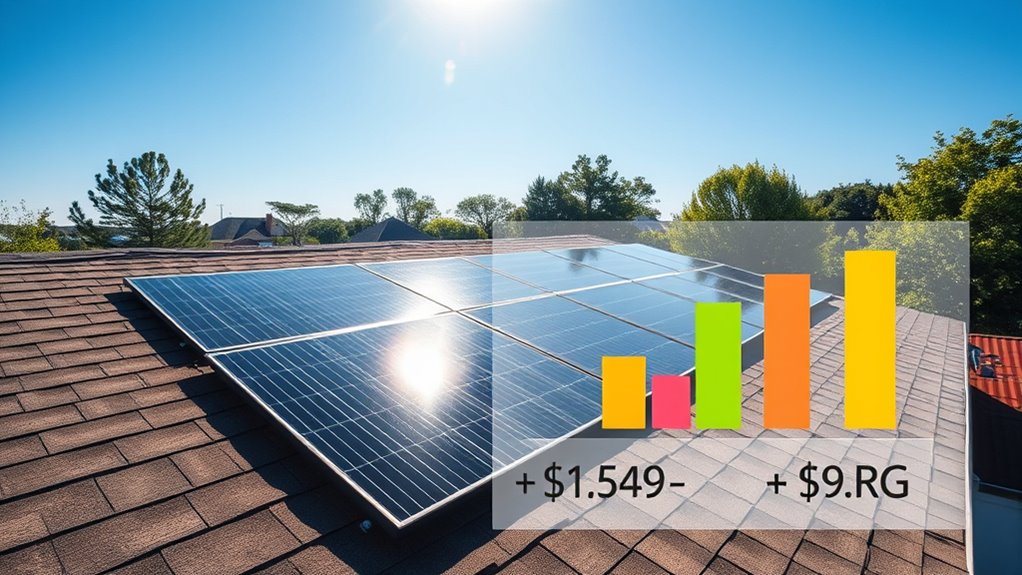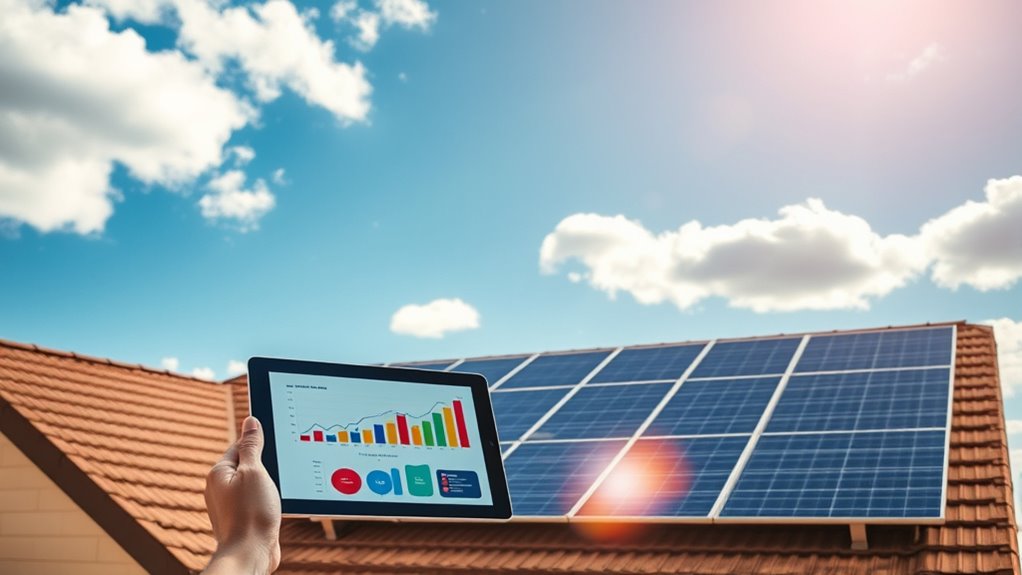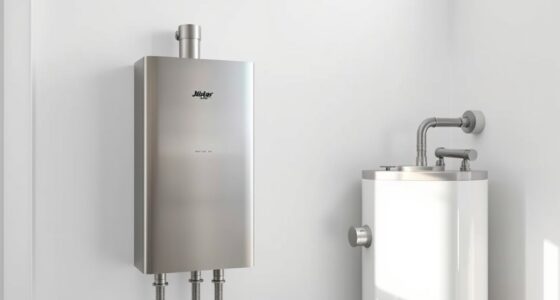To calculate the ROI of solar panels for your home, start by estimating your total costs, including installation, incentives, and tax credits. Then, determine your annual energy savings based on your household’s energy usage and local electricity rates. Over the system’s lifespan, sum your net savings and divide that by your total investment. Multiply the result by 100 to get your ROI percentage. Keep exploring to discover how factors like location and incentives influence your actual returns.
Key Takeaways
- Calculate total initial costs, including installation, incentives, rebates, and tax credits.
- Determine annual energy savings by multiplying household usage by local electricity rates.
- Estimate net lifetime savings over the system’s typical 25-year lifespan, factoring in maintenance and incentives.
- Divide net lifetime savings by total costs to find the ROI percentage.
- Consider payback period and location-specific factors to assess the investment’s profitability.

If you’re contemplating installing solar panels, understanding their return on investment (ROI) can help you make an informed decision. ROI measures how much you gain from your investment relative to its cost, which is crucial for evaluating whether solar power makes financial sense. To calculate ROI, you’ll need to consider your net lifetime savings from solar energy and compare that to the total cost of purchase and installation. The basic formula involves dividing your net lifetime savings by the total cost and multiplying by 100 to get a percentage. On average, in the United States, solar panels offer about a 10% ROI, but this figure isn’t set in stone. Your specific ROI depends heavily on factors like your location, the size of your system, and your home’s energy consumption.
The first step is understanding your net lifetime savings. This includes all the money saved on energy bills over the system’s lifespan, typically around 25 years. These savings are influenced by your household’s energy usage and the local electricity rates, which tend to be higher in some areas, increasing your potential savings. Additionally, government incentives, rebates, or tax credits can considerably reduce your initial costs and boost your overall savings. Some regions also allow you to sell excess energy back to the grid, further enhancing your net savings. To accurately estimate your savings, you need to account for ongoing incentives and the system’s expected lifespan. Proper system design and optimal placement can also significantly impact your energy production and overall ROI.
Next, you should determine your payback period, which is the time it takes for your solar panels to recover their initial cost through energy savings. To calculate this, divide the total installation cost by your annual savings. A shorter payback period generally indicates a better investment, especially if it’s markedly less than the panels’ lifespan. The payback period can vary widely depending on your location, system size, and energy consumption, but it’s a crucial factor in understanding your potential ROI. Remember, most solar panels last longer than the payback period, so once the initial investment is recovered, the energy savings continue to benefit you.
Various factors influence both ROI and payback period. Your location impacts how much sunlight your panels receive, directly affecting energy production. Larger systems produce more energy but cost more upfront, impacting both ROI and payback time. Local incentives like rebates and tax credits can dramatically reduce your initial expense, making the investment more attractive. Your household’s energy needs and the prevailing electricity rates also play essential roles; higher rates mean greater savings. To make a well-informed decision, you can use tools like spreadsheets, online calculators, or consult professionals who can provide detailed financial projections. These methods help you evaluate whether solar offers a worthwhile return, aligning your financial goals with your environmental interests. Evaluating the solar panel technology and its efficiency can further optimize your investment outcomes.
Frequently Asked Questions
How Does Energy Efficiency Impact ROI Calculations?
You might wonder how energy efficiency impacts your solar ROI. When your home uses less energy through efficient appliances and insulation, your solar system can offset a larger portion of your bills, boosting savings. High-efficiency panels produce more electricity, increasing your system’s output and speeding up your payback. Regular maintenance keeps your system running at its best, further enhancing your ROI by maximizing energy production and reducing overall energy costs.
What Are the Maintenance Costs Involved Over Time?
Maintenance costs for your solar panels are like planting seeds—small but essential for growth. You’ll spend around $150 to $500 annually, depending on system size and location. Cleaning, inspections, and minor repairs are typical expenses, but warranties often cover repairs. Over time, these costs stay relatively low compared to energy savings, helping you maximize your investment and keep your system running efficiently for 25+ years.
How Do Local Incentives Influence ROI?
Local incentives greatly boost your ROI by reducing upfront costs and increasing savings over time. When you take advantage of rebates, performance-based incentives, or tax exemptions offered by your city or utility, you pay less for installation and enjoy lower ongoing expenses. These incentives can shorten your payback period, enhance your system’s value, and maximize your investment’s benefits, making solar energy more affordable and financially rewarding for you.
What Is the Typical Lifespan of Solar Panels?
The typical lifespan of solar panels ranges from 25 to 30 years. You’ll find that most panels operate effectively for over three decades, though their efficiency gradually decreases by about 0.5% annually. Factors like climate, quality, and maintenance influence how long your panels last. By choosing high-quality panels and maintaining them well, you can maximize their lifespan and get the most value from your investment.
How Does Climate Variability Affect Solar Panel Performance?
Climate variability affects your solar panel performance by altering sunlight exposure and temperature. Hotter temperatures can decrease efficiency, while increased cloud cover reduces energy production. Seasonal changes and humidity influence output, with snow and rain sometimes obstructing sunlight or cleaning panels. Regional differences mean you should consider local weather patterns, and adapting panel angles or adding cooling systems can help maximize efficiency despite climate fluctuations.
Conclusion
Calculating the ROI of solar panels isn’t just about numbers—it’s about investing in your future and the planet. Think about the power you can harness, the savings you’ll enjoy, and the positive impact on the environment. Some say solar is too costly or unreliable, but evidence shows it’s a smart, sustainable choice. Trust in the technology and your decision; solar panels can truly transform your home and your life for the better.









